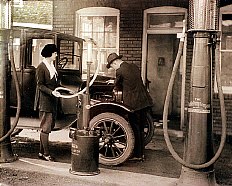1920-1929: THE ROARING 20s
Women use voting rights for first time in 1920
 |
 |
 |
 |
|
|
|
Liberated woman
Women, like this one pictured at a gas station on Broadway, were liberated enough in the 1920s to pump their own gas. Photo courtesy of Allen County-Fort Wayne Historical Society. |
|
|
By CONNIE HAAS ZUBER of The News-Sentinel
"New Voters Prove Competent and Alert," a headline in the Fort Wayne News and Sentinel reported on Election Day 1920, the first time that women in Fort Wayne were allowed to vote in a full election.
"The skeptics who said that the women should not be permitted to vote, 'because they will just make trouble at the polls,' or 'they will turn the elections into social affairs,' or 'they will get confused in the booths and slow things up' are angry with themselves today," the story reported.
Nov. 2, 1920, was a day women had been working toward for more than 70 years. The women's suffrage movement, as it was called, got its start in 1848 when Elizabeth Cady Stanton and Lucretia Mott called a women's rights convention in Seneca Falls, N.Y.
A constitutional amendment that would have given women the right to vote failed in Congress in 1878, and it was reintroduced every year for the next 40 years. But it wasn't until 1919, after women had contributed to the World War I effort, that the Senate passed the amendment and sent it to the states for approval.
The evening before that cold Tuesday in Fort Wayne when women first got to vote, the Fort Wayne News and Sentinel carried a warning to voters:
"Tomorrow for the first time in this city and county, thousands of women will cast their first votes and will do so under rather unfavorable circumstances. In all of the precincts, the capacity of the machines and booths will be taxed, and in some the congestion will be decidedly embarrassing."
The story announced the decision by election officials to enforce a state law limiting voters to one minute in the booth if voting by machine, and three minutes if using a paper ballot. And even that limitation left room for doubt whether everyone would be able to vote.
Women party workers helped at the polls.
"At the city hall polls, four Republican women were having a fine time this morning," the Election Day story reported. "Miss Florence Jeness was the first one to report and she beat the sun several minutes. However, by 8 o'clock Miss Winifred Spalding, Mrs. Edward Longfield and Miss Mollie Shreve were 'present and accounted for,' and then the fun began.
"Miss Shreve said she had nothing to do, for Mrs. Longfield was so efficient. Miss Jeness declared she was not cold. Miss Spalding was so busy helping the men keep their poll books straight that she did not have time to talk, but Mrs. Longfield was the center of attention with a pot of coffee piping hot, which she dispensed between looking up voters' names. All said they would be found at the same stand next election."
A record number of voters came to the polls, but things generally went smoothly. The one problem affected men and women alike all over town. Because some people had been registered in the wrong precincts -- and because state law at the time did not allow registration errors to be fixed on Election Day -- "scores of men and women" were not allowed to vote "through no fault of their own."
But predictions that women would get confused, stand around and gossip, and otherwise slow things did not come true, the newspaper reported.
"The women are voting with precision, and no confusion has been noted at any polling place in the city."